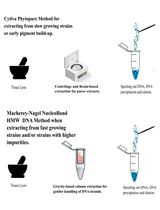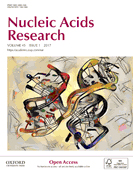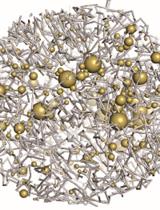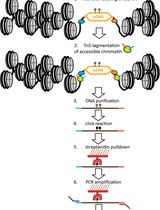- EN - English
- CN - 中文
Brief Protocol for EDGE Bioinformatics: Analyzing Microbial and Metagenomic NGS Data
EDGE生物信息学工具简要使用方法:分析微生物和宏基因组学下一代测序数据
(*contributed equally to this work) 发布: 2017年12月05日第7卷第23期 DOI: 10.21769/BioProtoc.2622 浏览次数: 11313
评审: Modesto Redrejo-RodriguezChao JiangAnonymous reviewer(s)

相关实验方案

优化高分子量 DNA 提取方法以用于 Magnaporthaceae 及其他禾本科根部真菌的长读长全基因组测序
Michelle J. Grey [...] Mark McMullan
2025年03月20日 3050 阅读
Abstract
Next-generation sequencing (NGS) offers unparalleled resolution for untargeted organism detection and characterization. However, the majority of NGS analysis programs require users to be proficient in programming and command-line interfaces. EDGE bioinformatics was developed to offer scientists with little to no bioinformatics expertise a point-and-click platform for analyzing sequencing data in a rapid and reproducible manner. EDGE (Empowering the Development of Genomics Expertise) v1.0 released in January 2017, is an intuitive web-based bioinformatics platform engineered for the analysis of microbial and metagenomic NGS-based data (Li et al., 2017). The EDGE bioinformatics suite combines vetted publicly available tools, and tracks settings to ensure reliable and reproducible analysis workflows. To execute the EDGE workflow, only raw sequencing reads and a project ID are necessary. Users can access in-house data, or run analyses on samples deposited in Sequence Read Archive. Default settings offer a robust first-glance and are often sufficient for novice users. All analyses are modular; users can easily turn workflows on/off, and modify parameters to cater to project needs. Results are compiled and available for download in a PDF-formatted report containing publication quality figures. We caution that interpreting results still requires in-depth scientific understanding, however report visuals are often informative, even to novice users.
Keywords: Genomics (基因组学)Background
EDGE bioinformatics was developed to help biologists rapidly process next-generation sequencing (NGS) data even if they have little to no bioinformatics expertise. EDGE is a highly integrated and interactive web-based platform that is capable of running many of the standard analyses that biologists require for viral, bacterial/archaeal, and metagenomic samples. EDGE provides an intuitive web-based interface for user input, allows users to visualize and interact with selected results, and generates a final detailed PDF report. Results in the form of tables, text files, graphic files, and PDFs, together with the raw output files of executed programs, can all be downloaded. A user management system allows tracking of an individual’s EDGE runs, along with the ability to share, post publicly, delete, or archive their results. Users can explore ongoing data processing within a user-friendly, intuitive web-based environment and interactive results are presented on a sample-by-sample basis. While EDGE was intentionally designed to be as simple as possible for the user, there is still no single ‘tool’ or algorithm that fits all use cases in the bioinformatics field. Our intent is to provide a detailed panoramic view of the user’s sample from various analytical standpoints. The initial release of EDGE in January 2017 provides six analytical workflows: pre-processing (data QC and host removal), assembly and annotation, reference-based analysis, taxonomy classification, phylogenetic analysis, and PCR analysis (validation and design). The latest release (version 1.5) includes several new features: identification of antimicrobial resistance and virulence genes, 16S/18S/fungal ITS analysis using QIIME, metadata collection/storage, and comparative analysis of taxonomic classification of multiple metagenomic samples. EDGE Bioinformatics is an ongoing effort to provide best of breed bioinformatics tools for NGS data analysis. Updates to current modules are continuous and more modules are under development.
Equipment
- Installing EDGE on a local server
- Hardware requirements: For high-throughput users that desire to process several large (50-500 million reads) samples at once, computers with 256 GB memory and 64 computing CPUs with 8 TB of local storage are highly recommended. The current computational hardware for one of the demonstration servers (https://bioedge.lanl.gov) is a Dell, PowerEdge R720 with 4 x Intel(R) Xeon(R) CPU E5-2630 v2 @ 2.60GHz = 24 cores (48 threads) and 512 GB RAM
- System requirements: EDGE bioinformatics has been tested on a Linux server with Ubuntu 14.04 or CentOS 7 operating systems, and requires 64 bit Linux environments. EDGE will not natively run on Mac OS X but, if enough computational resources are available for analyses, a Dockerized version of EDGE could be installed on a Mac in a Linux environment
- Essential libraries and dependencies required prior to EDGE software install are detailed in step-by-step command line instructions at https://edge.readthedocs.io/en/v1.5/system_requirement.html
- To simplify installation, a Docker image or a VM in OVF is also available. Information and links are located at http://edge.readthedocs.io/en/v1.5/installation.html#edge-docker-image and http://edge.readthedocs.io/en/v1.5/installation.html#edge-vmware-ovf-image
- Useful Resources: A web-based video tutorial series describing how to set-up and run each EDGE module can be found at http://tutorial.getedge.org. Written documentation for software install and how to run EDGE is available at https://edge.readthedocs.io/en/v1.5/
- Hardware requirements: For high-throughput users that desire to process several large (50-500 million reads) samples at once, computers with 256 GB memory and 64 computing CPUs with 8 TB of local storage are highly recommended. The current computational hardware for one of the demonstration servers (https://bioedge.lanl.gov) is a Dell, PowerEdge R720 with 4 x Intel(R) Xeon(R) CPU E5-2630 v2 @ 2.60GHz = 24 cores (48 threads) and 512 GB RAM
- Demo versions of EDGE
Los Alamos National Laboratory (LANL) and the Naval Medical Research Center (NMRC) host and/or support outward facing demo versions of EDGE bioinformatics for prospective users. Any computer with internet access can use the demo web-based EDGE bioinformatics platforms. To run analyses on provided test data, or samples deposited in the Sequence Read Archive (SRA), visit https://bioedge.lanl.gov. To upload your own data (maximum file size is 5 Gbp) and run EDGE, visit http://hobo-nickel.getedge.org
Software
- EDGE source code is open-source and can be located at https://github.com/LANL-Bioinformatics/EDGE/tree/v1.5
- FaQCs software (Lo and Chain, 2014)
- PhaME (Ahmed et al., 2015) software
Procedure
文章信息
版权信息
© 2017 The Authors; exclusive licensee Bio-protocol LLC.
如何引用
Philipson, C., Davenport, K., Voegtly, L., Lo, C., Li, P., Xu, Y., Shakya, M., Cer, R. Z., Bishop-Lilly, K. A., Hamilton, T. and Chain, P. S. G. (2017). Brief Protocol for EDGE Bioinformatics: Analyzing Microbial and Metagenomic NGS Data. Bio-protocol 7(23): e2622. DOI: 10.21769/BioProtoc.2622.
分类
微生物学 > 群落分析 > 宏基因组学
系统生物学 > 基因组学 > 测序
您对这篇实验方法有问题吗?
在此处发布您的问题,我们将邀请本文作者来回答。同时,我们会将您的问题发布到Bio-protocol Exchange,以便寻求社区成员的帮助。
提问指南
+ 问题描述
写下详细的问题描述,包括所有有助于他人回答您问题的信息(例如实验过程、条件和相关图像等)。
Share
Bluesky
X
Copy link










